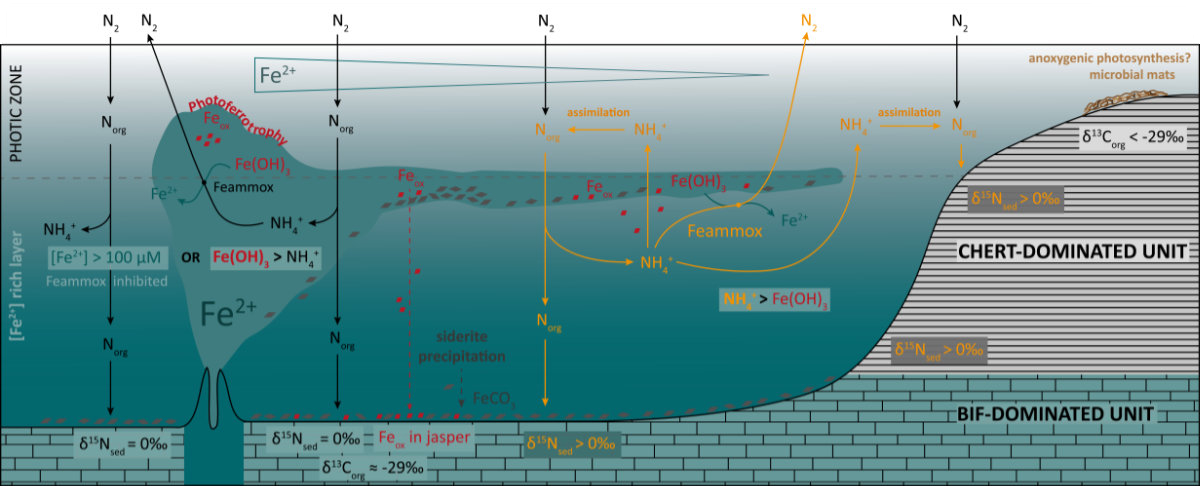Article d’Alice Pellerin publié dans Geobiology
Iron-mediated anaerobic ammonium oxidation recorded in the early Archean ferruginous ocean
Cette étude porte sur la caractérisation géochimique de roches sédimentaires sud-africaines âgées de 3,4 milliards d’années. Elle questionne comment le cycle de l’azote, nutriment essentiel à l’apparition et au développement de la biosphère terrestre, a pu fonctionner dans les conditions anoxiques et riches en fer caractéristiques des environnements de la Terre primitive.
Résumé en anglais
The nitrogen isotopic composition of organic matter is controlled by metabolic activity and redox speciation, and has therefore largely been used to uncover the early evolution of life and ocean oxygenation. Specifically, positive 15N values found in well-preserved sedimentary rocks are often interpreted as reflecting the stability of a nitrate pool sustained by water column partial oxygenation. This study adds much-needed data to the sparse Paleoarchean record, providing carbon and nitrogen concentrations and isotopic compositions for more than fifty samples from the 3.4 Ga Buck Reef Chert sedimentary deposit (BRC, Barberton Greenstone Belt, South Africa). In the overall anoxic and ferruginous conditions of the BRC depositional environment, these samples yield positive δ15N values up to +6.1‰. We argue that without a stable pool of nitrates, these values are best explained by non-quantitative oxidation of ammonium via the Feammox pathway, a metabolic co-cycling between iron and nitrogen through the oxidation of ammonium in the presence of iron oxides. Our data contribute to the understanding of how the nitrogen cycle operated under reducing, anoxic and ferruginous conditions, which are relevant to most of the Archean. Most importantly, they invite to carefully consider the meaning of positive 15N signatures in Archean sediments.
Référence
Pellerin, A., Thomazo, C., Ader, M., Marin-Carbonne, J., Alleon, J., Vennin, E. & Hofmann, A. – (2023) – Iron-mediated anaerobic ammonium oxidation recorded in the early Archean ferruginous ocean. Geobiology n/a. https://doi.org/10.1111/gbi.12540
Mots clés
biogeochemistry; nitrogen isotopes; Paleoarchean; Buck Reef Chert; ferruginous ocean; ammonium oxidation; Feammox
- extrait:
- lien_externe:
- kc_data:
- a:8:{i:0;s:0:"";s:4:"mode";s:0:"";s:3:"css";s:0:"";s:9:"max_width";s:0:"";s:7:"classes";s:0:"";s:9:"thumbnail";s:0:"";s:9:"collapsed";s:0:"";s:9:"optimized";s:0:"";}
- kc_raw_content:
Iron-mediated anaerobic ammonium oxidation recorded in the early Archean ferruginous ocean
 Cette étude porte sur la caractérisation géochimique de roches sédimentaires sud-africaines âgées de 3,4 milliards d’années. Elle questionne comment le cycle de l’azote, nutriment essentiel à l’apparition et au développement de la biosphère terrestre, a pu fonctionner dans les conditions anoxiques et riches en fer caractéristiques des environnements de la Terre primitive.
Cette étude porte sur la caractérisation géochimique de roches sédimentaires sud-africaines âgées de 3,4 milliards d’années. Elle questionne comment le cycle de l’azote, nutriment essentiel à l’apparition et au développement de la biosphère terrestre, a pu fonctionner dans les conditions anoxiques et riches en fer caractéristiques des environnements de la Terre primitive.Résumé en anglais
The nitrogen isotopic composition of organic matter is controlled by metabolic activity and redox speciation, and has therefore largely been used to uncover the early evolution of life and ocean oxygenation. Specifically, positive 15N values found in well-preserved sedimentary rocks are often interpreted as reflecting the stability of a nitrate pool sustained by water column partial oxygenation. This study adds much-needed data to the sparse Paleoarchean record, providing carbon and nitrogen concentrations and isotopic compositions for more than fifty samples from the 3.4 Ga Buck Reef Chert sedimentary deposit (BRC, Barberton Greenstone Belt, South Africa). In the overall anoxic and ferruginous conditions of the BRC depositional environment, these samples yield positive δ15N values up to +6.1‰. We argue that without a stable pool of nitrates, these values are best explained by non-quantitative oxidation of ammonium via the Feammox pathway, a metabolic co-cycling between iron and nitrogen through the oxidation of ammonium in the presence of iron oxides. Our data contribute to the understanding of how the nitrogen cycle operated under reducing, anoxic and ferruginous conditions, which are relevant to most of the Archean. Most importantly, they invite to carefully consider the meaning of positive 15N signatures in Archean sediments.
Référence
Pellerin, A., Thomazo, C., Ader, M., Marin-Carbonne, J., Alleon, J., Vennin, E. & Hofmann, A. – (2023) – Iron-mediated anaerobic ammonium oxidation recorded in the early Archean ferruginous ocean. Geobiology n/a. https://doi.org/10.1111/gbi.12540
Mots clés
biogeochemistry; nitrogen isotopes; Paleoarchean; Buck Reef Chert; ferruginous ocean; ammonium oxidation; Feammox
